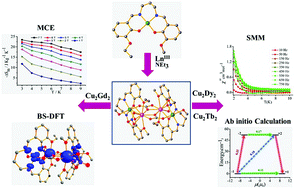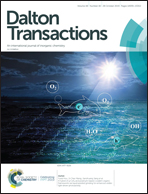The role of 3d–4f exchange interaction in SMM behaviour and magnetic refrigeration of carbonato bridged Cu II2Ln III2 (Ln = Dy, Tb and Gd) complexes of an unsymmetrical N2O4 donor ligand†
Abstract
The strategic design and synthesis of a new Cu(II) complex, [CuL] (1) of an asymmetrically dicondensed N2O4 donor ligand (where H2L = N-3-ethoxysalicylidene-N′-3-methoxysalicylidene-1,3-propanediamine) and its utilization as a metalloligand towards the synthesis of three new tetra-nuclear carbonato bridged Cu–Ln complexes [(μ4-CO3)2{(CuL)(MeOH)Ln(NO3)}2] (where Ln = Dy, Tb and Gd for complexes 2, 3 and 4 respectively) have been achieved. Each tetranuclear CuII2LnIII2 structure can be described as two μ2-phenoxo bridged CuIILnIII dinuclear units connected via two μ4–κ2:η1:η1CO32−. Single crystal X-ray diffraction studies show that complexes 2, 3 and 4 are isostructural and isomorphic. The LnIII centres are nona-coordinated with spherical capped-square antiprism geometry and the geometry around the CuII centre is distorted octahedral. The DC magnetic susceptibility and field dependent magnetization measurements reveal the ferromagnetic interactions between the CuII and LnIII centres in all three complexes. The ac susceptibility measurements under an applied bias field reveal the SMM behaviour of complexes 2 and 3 with Ueff 6.5 and 4.5 K, respectively. Complex 4 shows a notable magnetocaloric effect (MCE) with −ΔSm 23.5 J kg−1 K−1 for ΔH = 7 T at 3 K. The ab initio CASSCF/RASSI-SO/SINGLE_ANISO calculations predict that the observed SMM behaviour under an external dc field in 2 and 3 does not arise solely from the single ion anisotropy of the lanthanide ions. The exchange interactions (CuII–LnIII and LnIII–LnIII) lower the energy of the exchange coupled states as well as enhance QTM or tunnel splitting and play an important role in the overall magnetic properties of the complexes. Furthermore, to obtain more insight into the exchange interaction, BS-DFT calculations have been performed for complexes 2–4.



 Please wait while we load your content...
Please wait while we load your content...